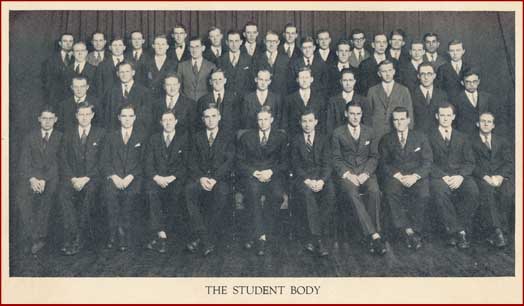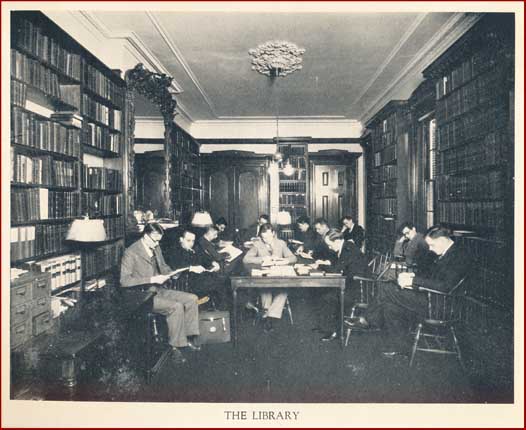Plans for a New Seminary
The “school of the prophets” was lost to Old School Presbyterianism. The great theologians of old Princeton — Alexander, Miller, Hodge, etc. — might still be buried in the cemetery plot of Princeton, but so also was buried their historic stand for the faith once delivered unto the saints. Re-organization of the trustees was now done and signers of the infamous Auburn Affirmation placed on the board. It was only a matter of time the fruits of liberalism would be manifest in the teachings of the classrooms.
Recognizing that sad truth, the Rev. Walter Buchcanan, pastor of Broadway Presbyterian Church in New York City, invited on June 17, 1929 a group of teaching and ruling elders to the University Club to respond to these developments. The following statement was approved by the group of elders: “Resolved: that this group will support the loyal members of the former Board of Directors of Princeton Theological Seminary in any step they may see fit to take (1) toward prevention by legal means the misuse of the Seminary’s funds, or (2) toward the formation of a new Seminary if they decide that it is necessary.” A wide latitude was allowed in this resolve, as you can see. Despite the new liberal members, see if we cannot keep Princeton Seminary from digressing away any further from the faith, but failing that, the possibility of a new seminary is on the table as well.
There were meetings taking place in other cities as well. Philadelphia was the site of a meeting of elders, including one in which finances were pledged for one year of the new seminary. The historic meeting which launched the new seminary took place on July 18, 1929 with seventy-eight teaching and ruling elders present at the YMCA in Philadelphia. The name of Westminster Theological Seminary was chosen at this meeting. An executive committee was chosen as composed of six (6) teaching elders and eight (8) ruling elders.
The teaching elders represented were: Maitland Alexander, Roy T. Brumbaugh, Walter Buchanan, Samuel Craig, Charles Schall, and Frank Stevenson. Ruling elders Roland Armes, Edgar Frutchey, Frederick Paist, James Runkin, T. E. Ross, James Schrader, John Steele, and Morgan Thomas were also present. Dr. Robert Dick Wilson, J. Gresham Machen,and O.T. Allis served as advisers.
The happy fruition of this meeting on that same year of 1929 was September 25, in which fifty students gathered at the Seminary campus at 1528 Pine Street in Philadelphia. A seminary was born!
 Pictured above, the Student Body of Westminster Theological Seminary, 1929-1930.
Pictured above, the Student Body of Westminster Theological Seminary, 1929-1930.
Words to Live By: One of the minor prophets of the Old Testament wrote that we were not to despise the day of small things. Certainly, this founding of Westminster Seminary in Philadelphia, Pa., was just a tiny speck in comparison with Princeton Theological Seminary in Princeton, New Jersey in the world’s eyes. But when your standard is the authoritative Word of God and the gospel of the Lord Jesus, then there is more that meets the eye in the start of this school which carried on the historic testimony of old Princeton. Let us learn to look ever to the Bible, not the world’s estimation, in your prayers and financial support of churches and institutions of the biblical gospel.
Before moving to its present location in Glenside, PA, Westminster Theological Seminary was first situated in a residence owned by Professor Oswald T. Allis. As Dr. Allis and his family removed to the top floors of the building, the first floor was reconfigured for an assembly room and chapel where daily prayer services were held, a room which would accommodate about sixty-five people.
Also on the first floor were small offices for the Registrar and the Secretary of the Seminary, as well as the dining hall and kitchen. The dining hall operated under the management of the Student Dining Club. with about forty-five men taking their meals there regularly, at a cost of about $6.50 per week. One evening a week was set aside for times of fellowship and singing following the dinner hour.
Classrooms and the Seminary library were located on the second floor of the building. The library held about 5,000 volumes at its inception. Three classrooms were also on this second floor, with about eighteen students typically in the largest class.
Also on this day :
July 18, 1823 marks the birth of Archibald Alexander Hodge, eldest son of Charles and Sarah Hodge.
Tags: Charles Schall, Frank Stevenson, Old School Presbyterianism, Princeton Theological Seminary, Samuel Craig, Walter Buchanan, Westminster Theological Seminary, YMCA


No comments
Comments feed for this article